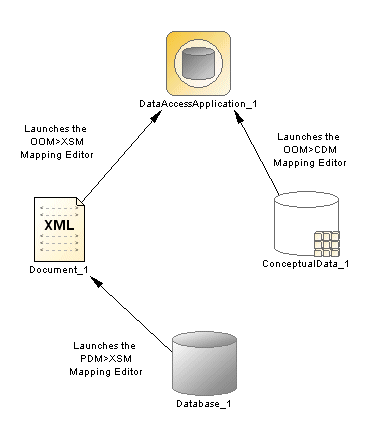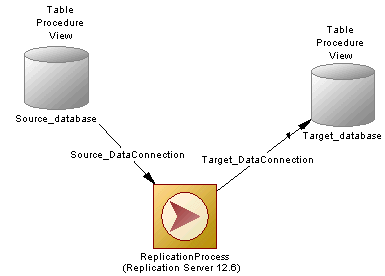When data movement is involved, data originates in a data source and is loaded to another target database or model.
You can create mappings in either of the following ways:
The following table lists the supported types of model-to-model mapping in PowerDesigner:
|
Source |
Target |
Mapping type |
|---|---|---|
|
PDM |
OOM |
O/R (Object-Relational) – to associate classes to tables to store OOM objects into a relational database. |
|
CDM |
OOM |
O/CDM (Object-Conceptual) – to associate classes and associations to CDM entities and associations or relationships. |
|
OOM |
OOM |
O/O (Object-Object) – to associate classes and attributes from one OOM to another. |
|
PDM |
PDM |
R/R (Relational-Relational) – to associate tables and views to other tables of another database. |
|
Multidimensional-Relational – to associate cubes, facts and dimensions to tables to populate OLAP cubes from relational databases. |
||
|
PDM |
XSM |
XML/R (XML-Relational) – to associate elements and complex types to PDM tables, views and abstract data types. |
|
OOM |
XSM |
XML/O (XML-Object) – to associate elements and complex types to OOM classes. |
|
XSM |
XSM |
XML/XML (XML-XML) – to associate elements and complex types from one XML Model to another in order to define how an XML document can be transformed into another (usually, using XSLT or Xquery). |
|
CDM |
CDM |
CDM/CDM (Conceptual-Conceptual) – to associate entities, associations, inheritances and data items from one CDM to another. |
|
OOM |
CDM |
CDM/O (Conceptual-Object) – to associate entities and associations to OOM classes and associations to clarify object relationships. |
|
LDM |
LDM |
LDM/LDM (Logical-Logical) to associate entities, relationships, and inheritances from one LDM to another. |
Each mapping is recorded in a query, a textual expression or an XPATH expression defined in the target object, which permits the selection of data from the data source and its transfer to the target model. In certain cases, you can further define the mapping by associating sub-objects in the target and source models.
Objects that Can Be Mapped
The following table lists the objects and sub-objects that can be mapped for each type of model:
|
Model |
Objects |
Sub-objects |
|---|---|---|
|
PDM |
Table |
Table column |
|
View |
View column |
|
|
Dimension |
Attribute |
|
|
Fact |
Measure |
|
|
Cube |
Measure |
|
|
Reference |
N/A |
|
|
OOM |
Class |
Class attribute, operation, association |
|
XSM |
Element |
Element attribute |
|
Complex type |
Complex type attribute |
|
|
CDM |
Entity |
Entity attribute |
|
Association/relationship |
Association attribute |
|
|
Inheritance |
Inheritance attribute |
|
|
Data item |
N/A |
|
|
LDM |
Entity |
Entity attribute |
|
Relationship |
N/A |
|
|
Inheritance |
Inheritance attribute |
Accessing Inter-model Mappings in the ILM
The Information Liquidity Model (ILM) provides a graphical view of various databases (PDM) and formats, such as XML document (XSM), data application (OOM), and conceptual data (CDM) together with the different transformations that operate between them. You can easily visualize or further define the correspondence between the various elements by right-clicking the data access link between these elements and opening the Mapping Editor:

For more information, see the "Migrating Deprecated Model Container Objects into a Project" section in the "Building Information Liquidity Diagrams" chapter in the Information Liquidity Modeling guide.
Creating Replications
The Mapping Editor also allows you to visualize and manage replications defined for RepServer and Mobilink in the ILM. It is available from the replication process contextual menu:

This ILM Mapping Editor is slightly different to the standard Mapping Editor:

For more information, see the "Using the Mapping Editor for Replications" chapter in the Information Liquidity Modeling guide.